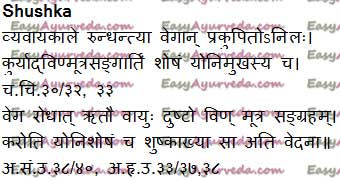Shushka Causative Factors, Symptoms, Pathogenesis, Treatment
By Dr Raghuram Y.S. MD (Ay) & Dr Manasa, B.A.M.S
Shushka is one among the 20 gynaecological disorders. It is a condition in which the vata aggravated due to suppression of natural urges during coitus or menstruation causes dryness in the vaginal canal. Read – Vata Dosha – Mastermind Behind All Body And Mind Activities
Table of Contents
Causes, pathology
Causative factors
- Vyavaya kale rundhantyaa vegaan – suppression of natural urges during coitus (Charaka)
- Vega rodhat rutau – suppression of natural urges during menstruation (Vagbhata)
Read – Symptoms Of Vata Dosha Increase And Imbalance – Vata Vruddhi Lakshana
Pathogenesis
Vata aggravated due to suppression of natural urges during coitus or menstruation produces a gynaecological disorder called shushk which is characterised by retention of urine and faeces and dryness of vagina. This dryness is due to absence of moistening fluid. Read – Vata Disorders (Vatavyadhi): Definition, Causes, Symptoms
Symptoms, Sanskrit verse
Symptoms
- Vin mutra sanga – retention / obstruction of urine and feces
- Shosham yoni mukhasya – dryness of orifice of vagina (Charaka)
- Yoni shosham – dryness of entire vagina / vaginal canal (Vagbhata)
- Ativedana – severe pain in vagina / uterus
- Nashtartavam – amenorrhea (commentator Adhamalla)

Modern correlation
Modern correlation and comparative study
We find a very short description of Shusk gynaecological disorder. With this piece of information, it becomes very difficult to establish its correlation with any condition explained in modern medicine. But a hypothetical understanding and comparison may be tried. Read – Vaginal Itching: Causes, Symptoms, Ayurveda Remedies, Tips
Psychological upset caused by suppression of natural urges may influence pituitary gland and its hormones via hypothalamus. This may consequently produce hypoestrogenic condition. This would eventually cause dryness and pain in the vagina.
Effect of autonomous nervous system may cause retention of urine and faeces. Read – Dysuria: Causes, Remedies, Tips, Diet, Ayurvedic Treatment
Amenorrhea will always be present in hypo-estrogenic conditions. This has been explained rightly by commentator Adhamalla.
Considering all these points, Sushka gynaecological disorder appears to be description of ‘estrogen deficiency’.
Treatment
Treatment of Suska gynaecological disorder
Uttara basti – intra-vaginal or intra-uterine enema shall be administered using medicated oil processed with Jeevaniya group of herbs
Vatahara krama – all measures capable of mitigating the vitiated vata should be adopted Read – How To Balance Vata Dosha? Line Of Treatment And Reasoning
Utkarika – poultice prepared with barley, wheat, yeast, Saussurea lappa, dill seeds, Sida cordifolia, Callicarpa macrophylla and Ipomea reniformis should be done, introduced inside the vagina
Jeevaniya varga siddha ksheera – Dryness of vagina, a complication of nasya i.e. nasal medication given to woman on fifth day of her menstruation should be treated with herbs described under yusha adhyaya or pushpa adhyaya chapter or with milk medicated with jeevaniya group of herbs.
Click to Consult Dr Raghuram Y.S. MD (Ayu) – Email / Skype









